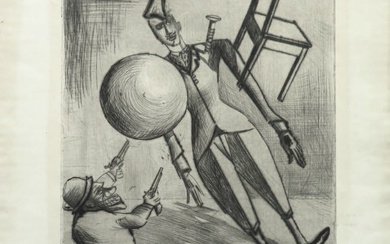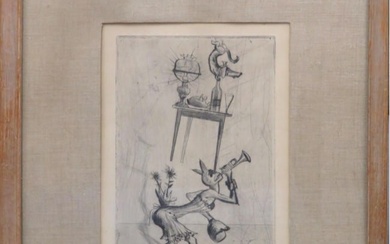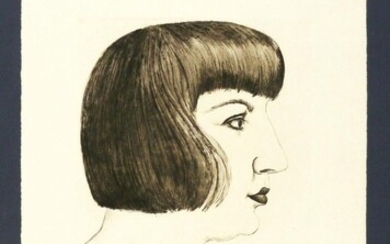OTTO DIX Lustmord I. Drypoint, 1922. 275x347 mm; 10 7/8x13 3/4 inches, full...
OTTO DIX
Lustmord I.
Drypoint, 1922. 275x347 mm; 10 7/8x13 3/4 inches, full margins. Signed, inscribed "No. II" and numbered 7/50 in pencil, lower margin. Published by the artist, Dresden. From Tod und Auferstehung. A very strong impression with richly-inked, velvety burr.
With--the original title page and justification page for Tod und Auferstehung, signed by the artist and numbered "VII" in pencil.
Dix (1891-1969) is known for his harsh depictions of the brutality of war in Germany. Tod und Auferstehung is a series of grisly scenes of the effects of violence; the portfolio includes a representation of a suicide, a scene of battle, a woman looking down upon a severed head, the decomposition of a dead body and then finally a spirit floating above mourners. Dix had studied Friedrich Nietzsche (1844-1900), and his theory of life, death, decay and renewal, which may have affected the subject matter of these etchings, along with the artist's own experiences of war atrocities he witnessed as a soldier on the Western Front during World War I.. Karsch 44.
View it on
Sale price
Estimate
Time, Location
Auction House
OTTO DIX
Lustmord I.
Drypoint, 1922. 275x347 mm; 10 7/8x13 3/4 inches, full margins. Signed, inscribed "No. II" and numbered 7/50 in pencil, lower margin. Published by the artist, Dresden. From Tod und Auferstehung. A very strong impression with richly-inked, velvety burr.
With--the original title page and justification page for Tod und Auferstehung, signed by the artist and numbered "VII" in pencil.
Dix (1891-1969) is known for his harsh depictions of the brutality of war in Germany. Tod und Auferstehung is a series of grisly scenes of the effects of violence; the portfolio includes a representation of a suicide, a scene of battle, a woman looking down upon a severed head, the decomposition of a dead body and then finally a spirit floating above mourners. Dix had studied Friedrich Nietzsche (1844-1900), and his theory of life, death, decay and renewal, which may have affected the subject matter of these etchings, along with the artist's own experiences of war atrocities he witnessed as a soldier on the Western Front during World War I.. Karsch 44.







